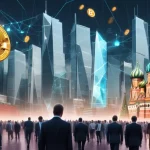Russia’s Crypto Surge: 52% of Investors Join Amid Sanctions and Strict Rules

Russia’s Crypto Boom: Over 50% of Investors Dive In Amid Sanctions and Regulation
A staggering wave of cryptocurrency adoption is sweeping through Russia’s financial elite, with a recent survey showing that 52% of qualified investors have already embraced digital assets, and another 38% are poised to jump in. This surge, fueled by economic sanctions and a thirst for alternative financial systems, signals a profound shift in a nation grappling with isolation from global markets. Yet, as enthusiasm soars, the heavy hand of regulation threatens to turn this revolution into an exclusive club for the ultra-wealthy.
- 52% of 1,500 qualified Russian investors hold crypto, with 38% more planning to invest, totaling 90% interest.
- Bank of Russia’s proposed rules limit direct crypto trading to millionaires, locking out most Russians.
- High volatility and blockchain ignorance pose significant barriers, despite trust in local platforms.
Russia’s Crypto Surge: The Numbers Behind the Hype
The numbers are jaw-dropping. A survey of 1,500 qualified investors—individuals over 20 years old living in cities with populations exceeding 100,000 and holding at least ₽50,000 ($600) in financial assets—reveals a deep fascination with cryptocurrency in Russia. Over half, 52%, have already invested in digital assets like Bitcoin and Ethereum, while 38% are gearing up to join them, pushing total interest to a staggering 90%. These aren’t casual speculators; they’re serious players in a global crypto market valued at $3.36 trillion, betting on digital currencies as both a speculative opportunity and a hedge against economic uncertainty. But what’s driving this rush, and can it sustain under the weight of state control? For more on the scale of this trend, check out the recent study on Russian investor adoption.
Why Now? Sanctions as the Unseen Catalyst
Russia’s economic landscape offers a grim backdrop to this crypto fever. Since 2022, international sanctions following geopolitical tensions have severed access to traditional financial systems, leaving the ruble wobbly and foreign currency transactions throttled. For many, crypto isn’t just a shiny new toy—it’s a lifeline. Reports indicate Russian oil companies are using Bitcoin and Ether through intermediaries to settle trades with partners in China and India, sidestepping Western banking restrictions. Picture a mid-level Moscow entrepreneur, unable to wire funds overseas for supplies, turning to Bitcoin as a quiet workaround. That’s the reality for some. Curious about how these sanctions shape investor behavior? Explore community insights on sanctions and crypto adoption in Russia.
Among surveyed investors, 57% are playing the long game, treating crypto as a store of value—digital gold for turbulent times. Another 32% use it to diversify portfolios, while 25% chase short-term trading thrills. About a third allocate 5-10% of their wealth to crypto-related instruments, showing calculated risk rather than reckless gambling. This isn’t blind hype; it’s a response to a squeezed economy where traditional options are drying up. But can crypto really outmaneuver the Kremlin’s grip? For a deeper look at the impact, see this discussion on sanctions affecting Russian crypto investors.
Trust in Local Platforms: Sovereignty or Surveillance?
One striking trend is the faith in homegrown infrastructure. A solid 78% of these investors prefer Russian-registered exchanges over international heavyweights like Binance or Coinbase, citing reliability (43%), low fees (24%), and ease of deposits or withdrawals (24%) as top reasons. Even more telling, 85% want to fund their crypto accounts in rubles, a clear push for financial sovereignty in a world of dollar dominance and sanctions. This aligns with Russia’s broader national strategy to loosen ties with foreign financial rails, prioritizing control over openness. For detailed stats on this preference, refer to the 2023 survey on Russian crypto adoption.
But let’s not be naive. While this trust in domestic platforms looks like a win for local innovation, it’s a double-sided coin. Are these exchanges truly bastions of freedom, or just Kremlin-sanctioned hubs with a crypto facade? Bitcoin was born to be borderless, yet Russian investors seem to be building a walled garden. If state oversight tightens, these platforms could morph into tools of surveillance rather than liberation—a bitter irony for a technology meant to empower the individual over the institution.
Regulatory Roadblocks: A Millionaire-Only Club
Enter the Bank of Russia, playing hard-nosed bouncer at the crypto party. Their proposed “experimental legal regime,” rolled out in March and pending approval for a three-year run, aims to restrict direct crypto trading to “highly qualified investors”—those with an annual income of at least ₽50 million ($600,000) and ₽100 million ($1.2 million) in securities or deposits. To put that in perspective, these thresholds cater to less than 1% of the population, essentially barring everyday Russians from the game. On top of that, the central bank wants to ban crypto settlements between residents outside this elite circle, with penalties for anyone who dares defy. Learn more about these strict regulatory proposals from the Bank of Russia.
Their reasoning? Crypto isn’t legal tender, lacks jurisdictional backing, and is a high-stakes gamble prone to wild swings and total loss. They’re not entirely wrong—Bitcoin’s rollercoaster can turn a nest egg into dust in hours. But this level of gatekeeping stinks of overreach, choking the accessibility that decentralization stands for. In a half-step toward progress, the Bank is piloting non-deliverable crypto derivatives—financial bets on Bitcoin’s price without owning the asset, like wagering on a stock without buying shares. The Moscow Exchange is also prepping Bitcoin futures, contracts to buy or sell BTC at a future date for a set price, based on a domestic index. Meanwhile, a dedicated crypto exchange for these elite investors is in the works, as confirmed by recent updates from the Central Bank and Finance Ministry. For the latest on this development, see Moscow Exchange’s Bitcoin futures launch updates.
Russian Finance Minister Anton Siluanov remarked, “This will legalize crypto assets and bring crypto operations out of the shadows,” signaling a move to regulate rather than outright suppress.
Fair point, but when the entry fee is higher than most people’s lifetime earnings, it’s tough to call this a win for financial inclusion. Satoshi didn’t code Bitcoin for oligarchs—he built it for the underdogs. For an overview of the broader regulatory context, check out the legal status of crypto in Russia and beyond.
Knowledge Gaps and Volatility: The Silent Killers
Beyond the regulatory iron fist, practical hurdles loom large. High volatility remains a gut punch for hesitant investors—Bitcoin’s price swings can make or break fortunes overnight. Worse, there’s a glaring lack of blockchain knowledge among the general populace. For the uninitiated, blockchain is the tech behind Bitcoin, a shared, uneditable ledger of transactions spread across a network of computers, cutting out middlemen like banks. Think of it as a public Google Doc that no one can tamper with unless everyone agrees. Sounds empowering, right? Yet without understanding basics like private keys—your personal password to access crypto— it’s a confusing black box ripe for scams or costly fumbles. For additional context on regulatory challenges, read about the Bank of Russia’s 2023 crypto trading restrictions.
This knowledge gap screams for action. Grassroots initiatives or even state-backed blockchain courses could demystify wallets and transactions, while exchanges might integrate tutorials to curb newbie disasters. Without better education and risk management tools, crypto in Russia risks staying a niche plaything for the informed elite, rather than a mainstream tool for the masses. Volatility fears won’t vanish, but arming investors with know-how could dull the edge.
Freedom vs. Control: Russia as a Global Microcosm
Let’s zoom out. Russia’s crypto saga mirrors a worldwide tug-of-war between blockchain’s promise of liberation and the state’s instinct to clamp down—a battle Bitcoin was forged to fight. On one hand, 90% interest among qualified investors showcases crypto’s raw appeal as a censorship-resistant asset, a defiant dodge around global financial exclusion. On the other, the state’s vice grip via regulation threatens to morph this revolution into a sandbox for the 1%. Compare this to El Salvador, where Bitcoin is legal tender for all, or India, where heavy taxes stifle adoption. Russia’s path—enthusiasm throttled by elitism—feels like a uniquely bitter middle ground.
As a Bitcoin maximalist, I can’t help but grit my teeth at how this betrays BTC’s core mission of empowering everyone, not just tycoons. Still, I’ll concede that altcoins and other protocols have a role here. Ethereum’s smart contracts could enable decentralized trade agreements for Russian firms dodging sanctions, while stablecoins like USDT already facilitate cross-border payments. Utility often trumps ideology in a squeezed economy—diversity in this space isn’t just innovation, it’s survival.
Russia’s crypto boom is a stark reminder that adoption doesn’t equal freedom. It’s a call to push harder against barriers that keep this tech from the average person’s hands. Imagine a young Russian coder, eager to invest his savings in Bitcoin, only to find the regulatory door slammed shut. That’s the reality for millions. If crypto is to change the world, it can’t just be a rich man’s wager. Keep that in mind as we watch this space unfold—and remember, it’s a high-stakes arena. Volatility can erase gains in a flash, and regulatory shifts can lock out players overnight. Proceed with eyes wide open.
Key Takeaways and Questions on Russia’s Crypto Landscape
- What’s fueling the cryptocurrency boom among Russian investors?
Economic sanctions since 2022, ruble instability, and blocked access to global finance drive investors to Bitcoin and Ethereum as alternative stores of value and trade mechanisms. - How restrictive are Russia’s crypto regulations in 2023?
Brutally so—the Bank of Russia limits direct crypto trading to ultra-wealthy elites with millions in income and assets, sidelining most Russians and banning everyday crypto payments. - Why do Russian investors favor domestic crypto exchanges?
Trust in reliability, lower fees, and ruble transactions push 78% toward local platforms, reflecting a broader quest for financial sovereignty amid global tensions. - Can Bitcoin and blockchain thrive under Russia’s tight state control?
It’s a long shot—while investor interest hits 90%, heavy-handed rules risk turning decentralized tech into a state-monitored playground for the rich, not the masses. - What’s the biggest obstacle to wider crypto adoption in Russia beyond regulation?
High volatility and a severe lack of blockchain education—many don’t grasp private keys or decentralized ledgers—block mainstream uptake, demanding better tools and public awareness.



